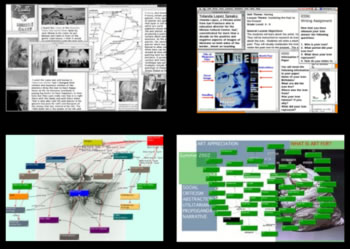Critical Thinking
Pamela G. Taylor's talk on Critical Thinking and and through Hypertext and Art Education (Breeze) is a nice example of an online lecture. (This is a nice use of Macromedia Breeze, a tool I've not heard much about...)
One of Taylor's students makes a useful point about the way the hypertextuality of a Storyspace art portfolio or Tinderbox notebook makes her confront the essence of critical inquiry:
I'll start something in the computer hypertext, and then Ill discover something really exciting that may have influenced the artist... So I go to a book or the Internet and research that and then, invariably, I find something else that takes me in an entirely different direction. I just don't feel I can know enough or find out enough anymore. It just doesn't stop! It's changed everything!

The formal Innovate paper is also online. (registration required).
Put simply, students began to think about their thinking as a result of their hypertextual experiences. As they saw the connections between history, ideas, art, and popular culture, they created electronic links; as they created links, their thinking became more complex and critically reflective so that they could explain the significance of those links. The more they worked on their computer hypertexts, however, the messier those hypertexts became. Opening a student file and finding a computer screen filled with a dizzying array of lines and arrows amidst many boxes often disoriented readers (Exhibit 9). However, as Caine and Caine state, 'We are meant to learn from naturally complex and 'messy' experiences' (1997, 11).